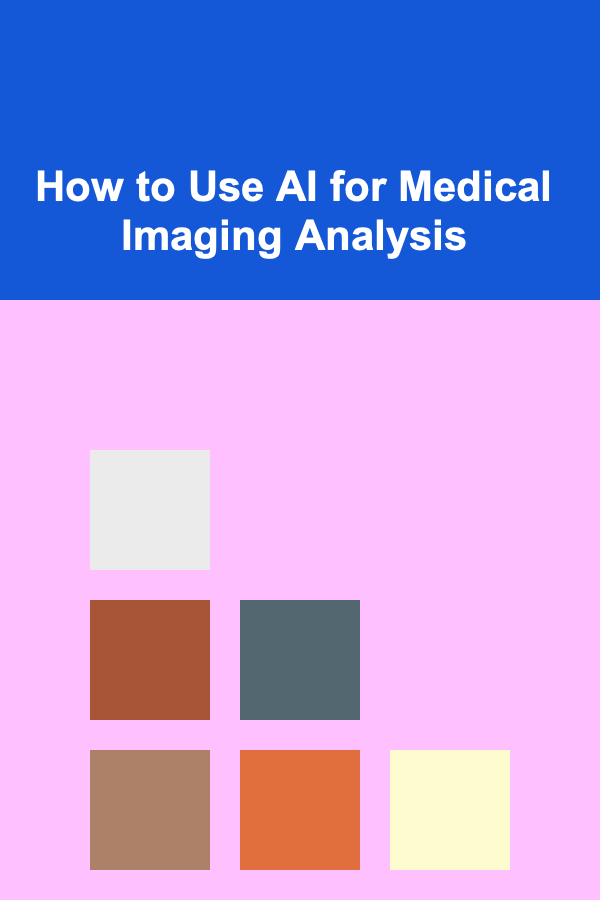
How to Use AI for Medical Imaging Analysis
ebook include PDF & Audio bundle (Micro Guide)
$12.99$7.99
Limited Time Offer! Order within the next:

Artificial intelligence (AI) is rapidly transforming the landscape of medical imaging analysis, offering unprecedented capabilities for improving diagnostic accuracy, accelerating workflows, and personalizing patient care. This article provides an in-depth exploration of how to leverage AI effectively in the context of medical imaging, covering various aspects from fundamental concepts to practical implementation strategies and future trends.
I. Introduction: The AI Revolution in Medical Imaging
Medical imaging, encompassing modalities such as X-ray, CT scans, MRI, PET, and ultrasound, plays a crucial role in the detection, diagnosis, and monitoring of a wide range of diseases. The sheer volume of images generated daily, coupled with the complexity of interpreting them, presents significant challenges for radiologists and other healthcare professionals. AI, particularly deep learning, offers a powerful solution by automating image analysis tasks, enhancing diagnostic capabilities, and ultimately improving patient outcomes.
The traditional workflow often involves radiologists manually reviewing hundreds or even thousands of images to identify subtle abnormalities, a process that can be time-consuming and prone to human error. AI algorithms, trained on vast datasets of annotated images, can rapidly identify patterns and anomalies that might be missed by the human eye, leading to earlier and more accurate diagnoses. This automation also frees up radiologists to focus on more complex cases and other clinically relevant tasks.
Beyond detection and diagnosis, AI also contributes to improved treatment planning. By segmenting anatomical structures and quantifying disease burden, AI algorithms provide valuable information for surgical planning, radiation therapy targeting, and personalized medicine approaches. AI-driven image analysis also facilitates more efficient monitoring of treatment response, allowing clinicians to adjust treatment strategies based on objective measures of disease progression or regression.
II. Foundational Concepts: Understanding the AI Landscape
Before diving into practical applications, it's essential to understand the core AI concepts that underpin medical imaging analysis. This includes familiarizing oneself with key terms, algorithms, and data requirements.
A. Machine Learning vs. Deep Learning
Machine learning (ML) is a broader field of AI that focuses on enabling computers to learn from data without being explicitly programmed. ML algorithms learn patterns and make predictions based on training data. Common ML algorithms used in medical imaging include support vector machines (SVMs), random forests, and logistic regression. These algorithms often require feature engineering, where domain experts manually extract relevant features from images, such as texture, shape, and intensity.
Deep learning (DL) is a subset of ML that utilizes artificial neural networks with multiple layers (hence "deep") to automatically learn complex patterns from raw data. Convolutional neural networks (CNNs) are particularly well-suited for image analysis due to their ability to extract spatial hierarchies of features. Unlike traditional ML, DL algorithms automatically learn relevant features from the images themselves, eliminating the need for manual feature engineering. This makes DL more adaptable to complex image data and often leads to superior performance. Examples of CNN architectures commonly used in medical imaging include ResNet, U-Net, and VGGNet.
B. Key Algorithms and Architectures
Several specific algorithms and architectures are frequently employed in medical imaging analysis:
- Convolutional Neural Networks (CNNs): These are the workhorses of image analysis, excelling at feature extraction and pattern recognition. CNNs consist of multiple layers of convolutional filters that learn to detect specific features in the image. Pooling layers reduce the dimensionality of the data, making the network more robust to variations in image size and orientation. Fully connected layers at the end of the network perform classification or regression. * Recurrent Neural Networks (RNNs): While CNNs are dominant in static image analysis, RNNs are useful for analyzing sequential data, such as video sequences or time series data derived from medical images (e.g., perfusion MRI). Long Short-Term Memory (LSTM) networks are a type of RNN particularly well-suited for handling long-range dependencies in sequential data. * Generative Adversarial Networks (GANs): GANs consist of two networks, a generator and a discriminator, that compete against each other. The generator tries to create realistic synthetic images, while the discriminator tries to distinguish between real and generated images. GANs can be used for data augmentation (generating more training data), image enhancement, and anomaly detection. * U-Net: A specialized CNN architecture particularly well-suited for image segmentation. U-Net has an encoder-decoder structure, where the encoder progressively downsamples the image to extract features, and the decoder progressively upsamples the features to reconstruct a segmentation map. Skip connections between the encoder and decoder allow the network to preserve fine-grained details, resulting in more accurate segmentation.
C. Types of Medical Imaging Tasks
AI can be applied to a variety of medical imaging tasks, including:
- Image Classification: Categorizing images based on the presence or absence of a specific disease or finding (e.g., classifying a chest X-ray as normal or pneumonia). * Object Detection: Identifying and localizing specific objects within an image (e.g., detecting lung nodules in a CT scan). This involves not only identifying the object but also drawing a bounding box around it. * Image Segmentation: Dividing an image into distinct regions corresponding to different anatomical structures or pathological areas (e.g., segmenting the brain into different tissue types, or segmenting a tumor from surrounding tissue). * Image Registration: Aligning two or more images of the same anatomy acquired at different times or using different imaging modalities (e.g., registering a pre-operative MRI to an intra-operative CT scan). * Image Enhancement and Reconstruction: Improving the quality of images or reconstructing images from incomplete or noisy data (e.g., reducing noise in an MRI scan, or reconstructing a 3D image from a limited number of 2D projections).
D. Data Requirements: The Importance of Quality and Quantity
The performance of AI algorithms, especially deep learning models, is heavily dependent on the quality and quantity of training data. Large, well-annotated datasets are essential for training robust and accurate models. Key considerations include:
- Dataset Size: Deep learning models typically require thousands or even millions of images for training. The exact number depends on the complexity of the task and the variability of the data. * Data Quality: Images should be of high quality, with minimal artifacts and noise. Preprocessing steps such as noise reduction and image normalization may be necessary. * Annotation Quality: Accurate and consistent annotations are crucial. Annotations can include bounding boxes, segmentation masks, or labels indicating the presence or absence of a disease. Ideally, annotations should be performed by experienced radiologists or other healthcare professionals. * Data Bias: It's important to be aware of potential biases in the training data. For example, if the training data primarily consists of images from a specific demographic group, the model may perform poorly on images from other groups. Efforts should be made to create diverse and representative datasets. * Data Augmentation: Techniques like rotation, flipping, scaling, and adding noise can be used to artificially increase the size of the training dataset and improve the model's robustness.
III. Implementing AI for Medical Imaging Analysis: A Practical Guide
Implementing AI for medical imaging analysis involves several key steps, from selecting the appropriate tools and technologies to training and validating the model.
A. Choosing the Right Tools and Technologies
Several open-source libraries and commercial platforms are available for developing and deploying AI solutions for medical imaging. Popular choices include:
- Python: The dominant programming language for data science and AI, with a rich ecosystem of libraries for numerical computation, machine learning, and image processing. * TensorFlow: A powerful open-source deep learning framework developed by Google. TensorFlow provides a flexible platform for building and training complex neural networks. * PyTorch: Another popular open-source deep learning framework developed by Facebook. PyTorch is known for its ease of use and dynamic computation graph, making it a good choice for research and experimentation. * Keras: A high-level API that runs on top of TensorFlow, PyTorch, or other deep learning frameworks. Keras simplifies the process of building and training neural networks, making it accessible to a wider range of users. * Medical Imaging Libraries: Libraries like SimpleITK, ITK, and DICOM provide tools for reading, writing, and processing medical image data in various formats (e.g., DICOM). * Cloud Platforms: Cloud platforms like Amazon Web Services (AWS), Google Cloud Platform (GCP), and Microsoft Azure offer a variety of services for developing and deploying AI solutions, including access to powerful computing resources and pre-trained AI models.
B. Data Preprocessing and Preparation
Data preprocessing is a critical step in the AI pipeline. It involves cleaning, transforming, and preparing the data for training the AI model. Common preprocessing steps include:
- Image Resizing and Normalization: Resizing images to a consistent size and normalizing pixel intensities to a specific range (e.g., 0 to 1) ensures that the model receives consistent input and converges faster. * Noise Reduction: Applying filters to reduce noise in the images can improve the accuracy of the model. * Artifact Removal: Identifying and removing artifacts, such as motion artifacts or metal artifacts, can prevent the model from learning spurious patterns. * Bias Field Correction: Correcting for intensity variations caused by magnetic field inhomogeneities in MRI scans can improve the accuracy of segmentation algorithms. * Data Augmentation: As mentioned earlier, data augmentation techniques can be used to increase the size of the training dataset and improve the model's robustness.
C. Model Training and Validation
Training an AI model involves feeding the preprocessed data to the model and adjusting its parameters to minimize the error between the model's predictions and the ground truth. The dataset is typically split into three subsets:
- Training Set: Used to train the model. * Validation Set: Used to tune the model's hyperparameters and prevent overfitting (when the model learns the training data too well and performs poorly on new data). * Testing Set: Used to evaluate the final performance of the model on unseen data.
During training, the model's performance is monitored using metrics such as accuracy, precision, recall, F1-score, and area under the ROC curve (AUC). The hyperparameters of the model are adjusted based on the performance on the validation set. Once the model is trained, its performance is evaluated on the testing set to obtain an unbiased estimate of its generalization ability.
D. Evaluation Metrics and Performance Assessment
Choosing the right evaluation metrics is crucial for assessing the performance of an AI model. Common metrics used in medical imaging analysis include:
- Accuracy: The proportion of correctly classified images. However, accuracy can be misleading if the dataset is imbalanced (e.g., if there are many more negative cases than positive cases). * Precision: The proportion of images classified as positive that are actually positive (also known as positive predictive value). * Recall: The proportion of actual positive images that are correctly classified as positive (also known as sensitivity). * F1-Score: The harmonic mean of precision and recall, providing a balanced measure of performance. * Area Under the ROC Curve (AUC): A measure of the model's ability to discriminate between positive and negative cases. AUC ranges from 0 to 1, with higher values indicating better performance. * Dice Coefficient: A measure of the overlap between the predicted segmentation and the ground truth segmentation. Dice coefficient ranges from 0 to 1, with higher values indicating better overlap. * Intersection over Union (IoU): Similar to the Dice coefficient, IoU measures the overlap between the predicted segmentation and the ground truth segmentation.
E. Deployment and Integration into Clinical Workflows
Deploying an AI model into a clinical workflow requires careful planning and integration with existing systems. Considerations include:
- Integration with PACS (Picture Archiving and Communication System): The AI model should be able to seamlessly integrate with the hospital's PACS system to access and analyze medical images. * User Interface: A user-friendly interface is essential for allowing radiologists and other healthcare professionals to interact with the AI model and view its results. * Reporting: The AI model should generate clear and concise reports that summarize its findings and provide actionable insights. * Regulatory Compliance: AI models used for medical imaging analysis must comply with relevant regulations, such as FDA approval in the United States and CE marking in Europe. * Ongoing Monitoring and Maintenance: The performance of the AI model should be continuously monitored to ensure that it is maintaining its accuracy and reliability. The model may need to be retrained periodically to adapt to changes in the patient population or imaging protocols.
IV. Ethical Considerations and Challenges
The use of AI in medical imaging raises several ethical considerations and challenges that need to be addressed.
A. Data Privacy and Security
Medical images contain sensitive patient information, and it's crucial to protect this information from unauthorized access or disclosure. Data privacy and security measures should be implemented throughout the AI pipeline, from data collection to deployment.
B. Bias and Fairness
AI models can inherit biases from the training data, leading to unfair or discriminatory outcomes. It's important to be aware of potential biases in the data and to take steps to mitigate them. This may involve collecting more diverse and representative datasets, or using fairness-aware algorithms.
C. Transparency and Explainability
The "black box" nature of deep learning models can make it difficult to understand why a model makes a particular prediction. This lack of transparency can be a concern in medical applications, where it's important to be able to explain the reasoning behind a diagnosis or treatment recommendation. Research is ongoing to develop more explainable AI techniques that can provide insights into the decision-making process of AI models.
D. Responsibility and Accountability
It's important to clearly define the roles and responsibilities of humans and AI in the medical imaging workflow. Who is responsible if an AI model makes an incorrect diagnosis? How should radiologists interpret the results of AI algorithms? These are important questions that need to be addressed.
E. Algorithmic Drift
Over time, the performance of an AI model can degrade due to changes in the patient population, imaging protocols, or other factors. This phenomenon is known as algorithmic drift. Regular monitoring and retraining are essential to mitigate algorithmic drift and ensure the continued accuracy and reliability of the AI model.
V. Future Trends and Opportunities
The field of AI in medical imaging is rapidly evolving, with new technologies and applications emerging constantly. Some of the key future trends include:
- Federated Learning: A distributed learning approach that allows AI models to be trained on decentralized data sources without sharing the data itself. This is particularly relevant in healthcare, where data privacy concerns often limit the ability to share medical images. * Self-Supervised Learning: A learning paradigm that allows AI models to learn from unlabeled data. This is important because labeled medical images are often scarce and expensive to obtain. * Multimodal AI: Integrating information from multiple imaging modalities (e.g., CT, MRI, PET) to improve diagnostic accuracy and personalize treatment planning. * AI-Driven Drug Discovery: Using AI to analyze medical images and identify potential drug targets or predict drug response. * Personalized Medicine: Tailoring treatment strategies to individual patients based on their unique imaging characteristics and clinical history.
VI. Conclusion
AI has the potential to revolutionize medical imaging analysis, improving diagnostic accuracy, accelerating workflows, and personalizing patient care. By understanding the fundamental concepts, implementing best practices, and addressing the ethical considerations, healthcare professionals can harness the power of AI to transform the future of medical imaging.
The journey towards widespread adoption of AI in medical imaging requires a collaborative effort between clinicians, researchers, engineers, and policymakers. By working together, we can ensure that AI is used responsibly and effectively to improve the health and well-being of patients worldwide.

How to Declutter Your Home Before Staging
Read More
How to Plan for Taxes and Save Money Every Year
Read More
Mastering Graphic Design: Techniques and Trends for the Modern Graphic Designer
Read More
How to Break Bad Habits for Good
Read More
Choosing the Right Bike Repair Kit for Roadside Emergencies
Read More
10 Tips for Comparing Your Investment Performance to Benchmarks
Read MoreOther Products

How to Declutter Your Home Before Staging
Read More
How to Plan for Taxes and Save Money Every Year
Read More
Mastering Graphic Design: Techniques and Trends for the Modern Graphic Designer
Read More
How to Break Bad Habits for Good
Read More
Choosing the Right Bike Repair Kit for Roadside Emergencies
Read More